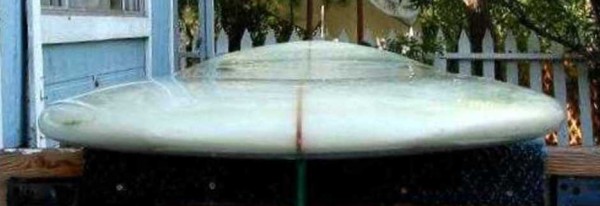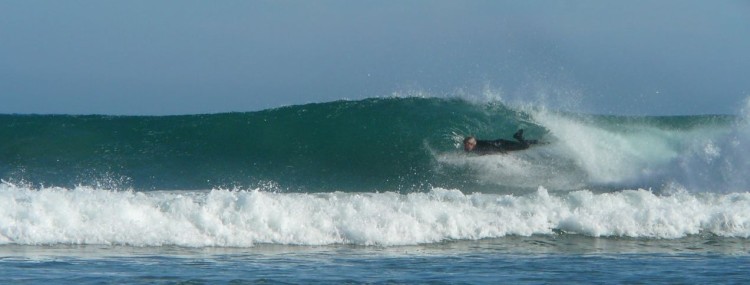Paul Gross Paipo Interview
December 20, 2009. Central California, CA (USA)
E-mail Interview by Jamie McClellan, based on questions by Bob Green & Jamie McClellan
Photos courtesy of Paul Gross
1.
In a 1976 Surfer Magazine article you wrote, “each individual piece of surfing
equipment exhibits a different set of strengths and weaknesses.” Most
would agree with you, however, your definition of surfing equipment is
likely to be broader than that of most people. What are your
thoughts on the respective strengths and weaknesses of mats,
bellyboards/paipos, and similar surf craft?
The
strengths of prone ridden surf crafts are legend. They are simpler and
more direct to ride. The learning curve is lightening quick. There is
no heroic standing or “ego-based style" to either blur the wave riding
experience -- or displace it completely. They can be ridden in
virtually any kind of wave. They can be paddled with just your arms, or
with arms and flippers, or just flippers. Or you can even wade out and
push into waves off the bottom with your feet!
They have the widest functional range of design and the widest range of
potential materials as well. Look at what Greenough accomplished with
his early flexible spoon kneeboards. Just because he rode boards that
didn’t need to float, a whole world of opportunities opened up for him.
His first flexible boards were created 45 years ago… and they are
leading edge to this very day!
More importantly, mats/bellyboards/paipos/bodyboards transcend the age
and experience and talent of the rider better than any surf craft. You,
me, Nat Young, Kelly Slater… who can tell the difference from the beach?
It’s purely a personal experience. How bitchin’ is that?
The drawbacks are really minor. I guess heavy crowds would be the biggest. That, and finding the right pair of fins.
2.
You’ve been a surfboard shaper, fin designer, experimented with hulls,
made hi-tech mats and pursued paths untravelled by many surfers. I’m
particularly interested in exploring your involvement with
prone-specific crafts (paipos, bellyboards of any sort,
hulls/longboards meant to be ridden prone/kneeling, and of course mats
and such).
Like
most people my age (I’m in my late 50’s) I started out on inflatable
rental mats as a youngster. And, like most kids, I thought that mats
were the training wheel phase of the surfing world. Real surfers stood
up on surfboards! That’s why we would pump out mats rock hard and try
to stand up on them. But, I distinctly remember going down to the water
the very first time I rode a stand up board, and immediately thinking
that I wasn’t having as much fun. But, I wrote it off as the dues of
being a real surfer. It was a few years before I realized that mats and
belly boards were more fun for me on most days.
Seeing George Greenough ride mats at Rincon was a revelation, because
here was a guy who could take the humblest of surf craft and out-surf
(depending on your perspective) everyone else in the water. And this
was at a time that whenever Rincon broke, the best surfers in
California were there. The water was filled with hot surfers, and
George could connect all three points with his $30 dollar Hodgeman raft,
blowing past name guys like they were standing still. Just amazing. It
gave me the impetus to keep riding a mat through my adolescent
years… when my growing sense of ego might have otherwise diverted me. I
guess that’s the true definition of a role model.
Even though I was immersed in mat riding, I became the first employee
at Morey Boogie back in the early 70’s! I got a ring-side seat to see
that phenomenon take place. I assembled the kits that Tom was
producing, and sent them out. But, I never really got into body
boarding, then or now. I’m not sure why. That said, it was fascinating
to see hard core surfers from all over the world instantly accept the
body board as a legitimate “alternative,” when mats and paipos were
generally laughed off the beach. Go figure.
I’ve always dabbled in belly boards and paipo boards, because, as a
surfboard shaper, there was a natural inclination to apply what I was
learning about stand up boards to prone boards. It’s been a kind of an
on-again, off-again thing however, because mat surfing has always been
my first love. Belly boards were an alternative I wanted to explore, to
see what I could come up with.
3. How many paipos/bellyboards do you estimate you’ve made over the years?
Not
that many belly boards or paipos…maybe a dozen. But, you get a lot out
of one craft. I remember one time, many years ago, Spyder Wills told me
he that he rode a belly board for years and years before trying
something else [see the Surfer Magazine article on Spyder Wills]. I was pretty young when he said that, and it took a few
years to appreciate what he meant. It takes a long time to sort out
what a belly board has to offer, even though it seems so simple on the
surface.
And you can learn a lot from one board because there are so many ways
to ride it correctly. Individual stand up boards have a much more
limited range in how they are surfed, so they can be sussed out pretty
quickly. Plus belly boards lasted a long time because, before leashes,
you lost them less often than standup boards. And there were no knee
or heel dents to ruin the deck. Plus they work well with a bit of
weight, so they didn’t need to be made fragile.
4. When was the first belly board? Who was it made for or what type of wave was it intended for?
The
first board I ever shaped, in the mid-60’s, was a belly board I made
for myself. It was a project for wood shop. And it wasn't a rounded off
piece of ply wood either -- although that would have been fine. It was
shaped out of 2" thick slab of pine, with rocker, s-deck taper, and
round rails. 4 feet long and 20 inches wide. I wanted it to look like a
small surfboard. It took the whole semester to finish it!
I had no specific intent for that board, it was just something to ride.
I was surfing mats and a longboard at the time, and I thought it would
be interesting to combine the pleasure of surfing prone with the solid
shape of a longboard. I have no idea what happened to it, but I would
give anything to have it back again!
5.
Can you describe a bit of your personal progression in surfcraft? Did
you start, as most did, on a rental raft? And has it now come full
circle?
Yes,
exactly. It’s odd you would ask that, because I went for a mat surf
this afternoon, and it dawned on me while I was out in the water that
I’m only a few years away from 50 years of mat riding. I guess that
qualifies as being full circle!
Even though I've been heavily involved with conventional stand up
surfing as a surfer and as a shaper, riding prone has always held a
fascination for me. It almost has the purity of bodysurfing, but with
added planing ability. Just being down in the water and using swim fins
makes it a blast. Plus you can travel so much more easily.
Belly boards and mats have influenced my stand up boards, for sure.
Standing on the tail of a surfboard and weilding the nose back and
forth seems stupid to me. I like the "flush" style of wave
riding... with the nose down on the water, on the verge of pearling, but
not quite. And taking the trim line across the wave. So I was attracted
to a trimming style of stand up surfing from the beginning, because of
mat riding and belly boards. Plus I’ve always been a minimalist when it
came to fins on surfboards, because mats and paipos used their rails to
hold in, and belly boards tended to have very small fins.
6.
I believe you have also made an "El Paipo Grande." What is the story
behind this board and what are it’s dimensions and design features?
The
"El Paipo Grande" was inspired by Richard Safady, a good friend and one
of my favorite surfers in the water. He used to ride Greg Liddle
displacement hull boards standing up. But in the 80's, he started to
ride his stand up boards on his knees. Then in the 90's he started
riding them lying down! A lot of his friends freaked. (One guy wanted
to stage an intervention! Seriously.) The speed Richard could generate
laying down was amazing, even on tiny waves. Roger Kelly, another
really good surfer, started riding his own stand up hulls laying down
around that time, and really got into it.
El Paipo Grande
We finally decided to build Roger an arm paddle board that was
dedicated to being ridden laying down. The deck was scooped out a bit,
and the hull was deeper throughout the back half of the board than a
stand up board. It was 8'8'' x 23 1/4". Around 3" thick. It turned out
to be one of Roger's two favorite boards of all time. And, El Paipo
Grande is a terrible board to ride standing up... which I think is
interesting. It kind of confirms that really is a belly board, not a
hybrid or a compromise.
I watched Roger surf Malibu one evening after he had been riding EPG
for a few months and really had it dialed in, and it was memorizing. He
would paddle into waves way up the point, just like he was on a
conventional stand up board, then he would pull himself so far forward
that his head was maybe 18" back from the tip of the nose. The hull in
the bottom would draw the board up into the pocket, and he would just
fly across these 3-4 foot waves with his head brushing the texture of
the lip of the wave the whole way across. Just wailing across the
point, wave after wave. No one would drop in on him, he was going too fast. And this was at Malibu!
Roger Kelly on El Paipo Grande (EPG)
7. What other bellyboards have you made?
As
I mentioned earlier, I've made about a dozen of them over the years,
and I can't remember them all clearly. Most of them have been
variations of either the classic Greenough kneeboard hull, or Greg
Liddle’s hulls. The Liddle style hulls trim well, and move across walls
very quickly, while the Greenough hulls want to carve off the bottom to
generate speed. I’ve always tried to incorporate both those
elements in belly boards.
I made a really radical Greenough hull paipo for Roger Kelly a few
years ago. We called that one the “Aqua Plane 1.” It had a very deep
belly under the nose, and was 5’ x 25” with a broad round tail, and around 1" thick in the middle, and 1/4" at the tail. The board has a 4" nose rocker and 3/8" tail rocker - it is almost straight flat the last 36 inches. Three
fin boxes, so he could try various fin combinations. A lot of people
have ridden that board, and everyone seems a bit confused by it. I rode
it the day it was finished, and it seemed like it needed really good
waves to get rolling.
Aqua Plane 1

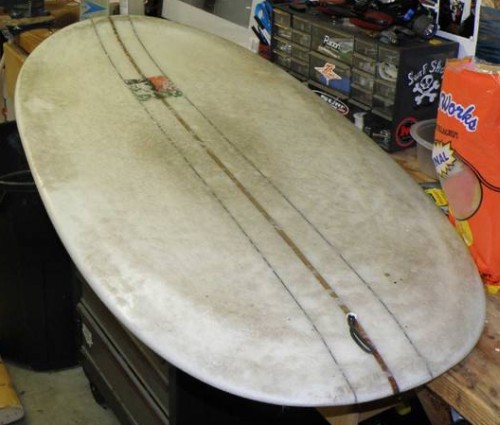


I shaped the “Aqua Plane 2” for Ricky Swallow just recently. It’s 5’4’’
x 23”, and has a less radical hull. The board is 1 5/8 inches thick in the middle and 3/8" at the tail and has a 2 3/4" nose rocker and 1/2" tail rocker. Ricky
is still getting it dialed in, so
we don't know how good it will be. But preliminary indications are that
it’s a lot more practical than Roger’s radical displacement hull. It
has two fin boxes placed well off the rail -- 4.5" out from the
stringer... and about that much in from the rails, and 4" up from the
tail. I haven't ridden the board, and Ricky Swallow has only ridden it
maybe 6 times, so we don't know those numbers yet. The verdict is still
out on the relative advantages and disadvantages of the two fins types
shown below since the board is still so new. My educated guess is
the small fins in the middle of the box will be close to ideal.
Aqua Plane 2
Fin box humps

View from the tail end of the board
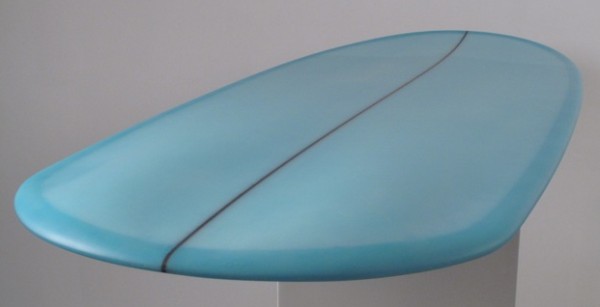
Top (left) and bottom (right) of the Aqua Plane 2
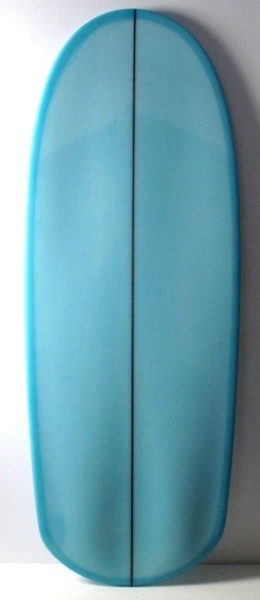 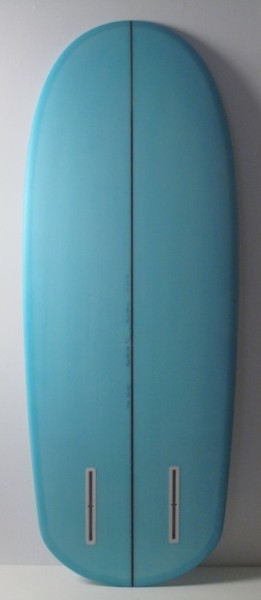
Cutout fins
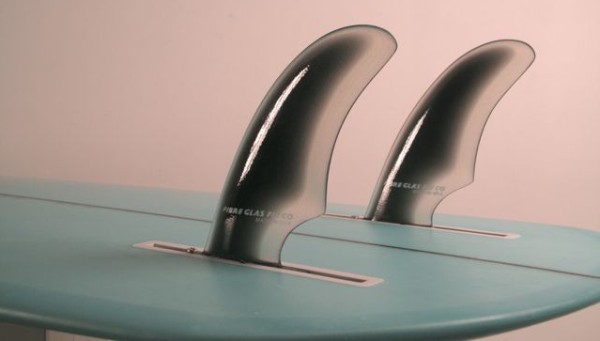
Small fins
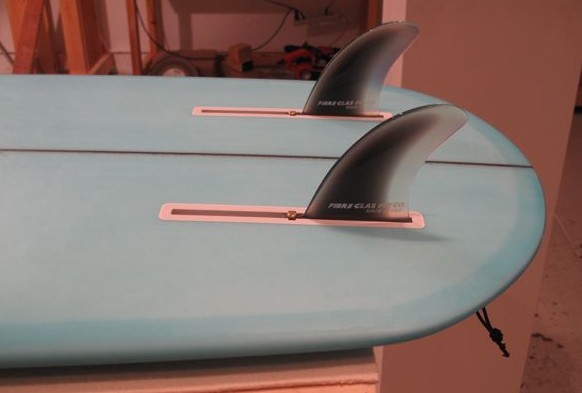
Bottom view from the tail with small fins
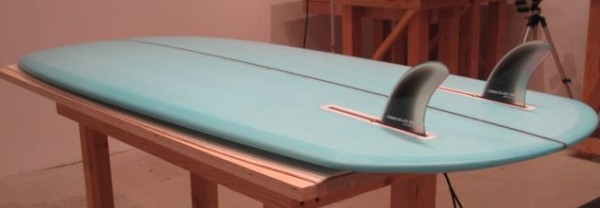
The Aqua Plane 1 with its blank
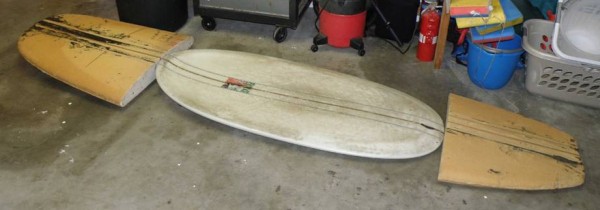
8. Have you ridden bellyboards much yourself or have you been reliant
on others as test pilots. If you rode them, what’s your preference in a
bellyboard and any particular surf stand out?
I
think I've ridden every one I've ever made, although they were usually
made for someone else. I tend to like a solid belly board in smaller,
cleaner waves. Belly boards plane out with less effort than mats, and
urban lifeguards generally don't hassle you as much when you take a
solid board out. They hate inflatables!
I ordered a true Hawaiian paipo, from Paul Lindbergh, about 10 years
ago, and got some time in on that. It just didn't seem right for
Califonian waves. I want to ride it in Hawaii some day, to be in the
right environment.
9. If you were to build a bellyboard tomorrow, what would be like? Would it be built primarily for speed or turning?
I
think my next belly board will be 5'10'' long, because that's how tall
I am. I’m going to try that approach to length in the future… make it as
long as you are. And it will be a pulled-in roundtail displacement
hull, similar to the 7 footers Greg Liddle made in the 70's and 80's...
with a single fin placed up off the tail a fair bit, and designed
purely for forward trimming and speed in smaller point waves.
I've
always kind of had a counter-intuitive approach to small wave surfing.
Since the short board revolution, most surfers have tried to
bring small wave surfing to big waves. But I want to bring big wave
surfing to small waves. I like clean tracks that flow with the grain of
the wave. It feels better to me, and seems more spiritual. I want to
achieve that feeling in a belly board, even in 2 foot waves.
10.
All design involves compromise. How would you alter the board’s design
to make it turn more easily, or conversely, be faster? Any changes
required for hollow or big waves?
I
like turning to generate speed on any size wave. Greg Loehr once said
that in small wave surfing, you try to build up speed in order to do
maneuvers, but in big waves, you do maneuvers to build up speed. That's
a keen observation, and it makes complete sense. But I like turning to
build speed all the time! So I don't see speed and maneuverability as
design opposites.
I use rocker numbers and wide point placement to vary the length of the
turns for a given board, stand up or belly riding. More rocker, shorter
lines. Less rocker, longer lines. Wide point back, shorter lines. Wide
point up, longer lines. That’s an oversimplification, but generally
it’s true, in my opinion.
Bigger or hollower waves call for longer and narrower boards... but I
tend to leave the hull and rails the same for all types of surf. I
adjust the dimensions. People think you can’t ride big hollow waves
with a displacement hull board. But you can if the outline is
appropriate.
11.
In 1976, you also wrote, “the wave-riding equipment most suited to your
own equipment may be as simple as putting on a pair of fins and "letting your body be the foil"” Can you comment on how mats and
bellyboards can also involve the body acting as a foil?
Mats
and bellyboards reshape your torso. So by thinking of them as craft
that "reshape your torso," they become a form of body surfing!
|
Additional Information: Surf Mats by Paul Gross, Fourth Gear Flyers (4GF). For more photos, info, community, tips, and tricks, be sure to visit the blog spot, Surfmatters, the "premiere surfmat rider’s blog on the net!" Also see the interview in Liquid Salt Surfing Magazine, "Paul Gross: A Special Feeling," by Mary Mills (January 17, 2010), or in PDF format.
|
|


